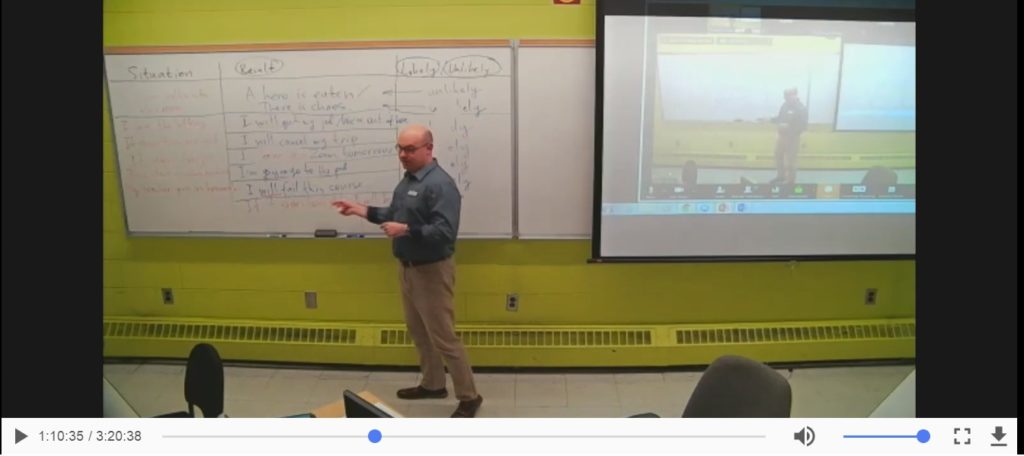AAA – Anywhere, Anytime, Anyplace Learning
Multimodal Classrooms > AAA Learning
What is AAA Learning?
Iorio, Feliziani, Mirri, Salomoni, and Vitali (2006) describe ‘anywhere, anytime, anyway’ as a slogan “associated to e-learning with the aim to emphasize the wide access offered by on-line education” (p. 3). For example, in banking, one has an array of choices: a teller, an ATM, telephone services or online. These choices allow the individual to decide where, when and how to interact with the bank. Within the educational context, an AAA environment allows the student to decide where, when and how he or she learns best. This is separate from an online institution (like Athabasca University) in that the student is able to have a face to face (F2F) classroom experience, and different from a traditional institution in that a student can study online, all within the context of the same classroom community. This means they can participate at home via web-conferencing, or physically come to class. The student, not the institution, is now making the choice, which increases democracy for the student. Simsek (2015) argues postsecondary has traditionally adopted a one size fits all model, but that this “…is not acceptable to the generation of digital natives who would like to get their education anywhere, anytime and anyway based on their circumstances” (p. 136).
History of AAA Learning at Algonquin
Various professors had seen the effect absenteeism had been having on classrooms, not only pedagogically, but also from a community and mental health perspective. These professors had started allowing some students to attend virtually using video-conferencing. These professors allied to form a group to advocate for more distance learning approaches with our existing face-to-face classrooms. It was then discovered that other professors had been experimenting with a variety of other distance tools like 3D environments and lecture capture. We also learned that the term “anywhere, anytime, anyway” appeared prominently in the 2012-2017 Strategic Plan and in Algonquin’s funding agreement with the Province of Ontario. We discovered that the Algonquin community had already identified the need for AAA learning, which is why it was in the Strategic Plan, so as a group of professors we have been advocating for the fruition of this promise.
The Language Institute was one of the first adopters. The Teachers of English as a Second or Foreign Language Program started experimenting with 3D environments and web-conferencing in 2013, which eventually led to the program fully adopting the students’ choice to attend virtually or physically. Later, the Language Instruction for Newcomers to Canada Program also adopted web- conferencing to give New Canadians flexibility in their learning and then the initiative moved into the English for Academic Purposes program. Along the way, the Language Institute discovered others doing AAA learning in the College, especially in Media and Design, and began working cooperatively. The AAA initiative eventually came before the College Technology Committee – Academic and the AAA Working Group was formed.
Doing AAA Learning
AAA learning is quite practical to implement from a technological and logistical perspective. In order to include web-conferencing in the classroom, a professor needs a webcam and basic training on a web-conferencing platform. The number of students is immaterial, as a class of 50 students could have 20 virtually and 30 physically, or 40 virtually and 10 physically, or any other conceivable configuration. This changes from day to day, depending on the students’ choices.

A great resource to get started is the Blended synchronous learning: A handbook for educators found at http://static.pseupdate.mior.ca.s3.amazonaws.com/media/links/ID11_1931_Bower__Report_handbook_2014.pdf
References
Bower, M., Dalgarno, B., Kennedy, G., Lee, M. J., & Kenney, J. (2014). Blended synchronous learning: A handbook for educators. Retrieved from http://static.pseupdate.mior.ca.s3.amazonaws.com/media/links/ID11_1931_Bower__Report_handbook_2014.pdf
Iorio, A. D., Feliziani, A. A., Mirri, S., Salomoni, P., & Vitali, F. (2006). Automatically producing accessible learning objects. Journal of Educational Technology & Society, 9(4), 3-16.
Simsek, A. (2015, July). Do massive open online courses offer a viable solution for essential problems in higher education? Paper presented at the International Conference on Technology in Education, Hong Kong (pp. 133-142). Berlin: Springer.